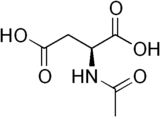N-Acetylaspartic acid, or N-acetylaspartate (NAA), is a derivative of aspartic acid with a formula of C6H9NO5 and a molecular weight of 175.139.
 | |
| Names | |
|---|---|
| IUPAC name
2-Acetamidobutanedioic acid[1]
| |
| Identifiers | |
3D model (JSmol)
|
|
| 1726198 S | |
| ChEBI | |
| ChEMBL | |
| ChemSpider | |
| ECHA InfoCard | 100.012.403 |
| EC Number |
|
| KEGG | |
| MeSH | N-acetylaspartate |
PubChem CID
|
|
| RTECS number |
|
| UNII | |
CompTox Dashboard (EPA)
|
|
| |
| |
| Properties | |
| C6H9NO5 | |
| Molar mass | 175.140 g·mol−1 |
| Appearance | Colourless, transparent crystals |
| Melting point | 137 to 140 °C (279 to 284 °F; 410 to 413 K) |
| Boiling point | 141 to 144 °C (286 to 291 °F; 414 to 417 K) |
| log P | −2.209 |
| Acidity (pKa) | 3.142 |
| Basicity (pKb) | 10.855 |
| Hazards | |
| GHS labelling: | |

| |
| Warning | |
| H315, H319, H335 | |
| P261, P264, P271, P280, P302+P352, P304+P340, P305+P351+P338, P312, P321, P332+P313, P337+P313, P362, P403+P233, P405, P501 | |
| Related compounds | |
Related alkanoic acids
|
|
Related compounds
|
|
Except where otherwise noted, data are given for materials in their standard state (at 25 °C [77 °F], 100 kPa).
| |
NAA is the second-most-concentrated molecule in the brain after the amino acid glutamate. It is detected in the adult brain in neurons,[2] oligodendrocytes and myelin[3] and is synthesized in the mitochondria from the amino acid aspartic acid and acetyl-coenzyme A.[4]
Function
editThe various functions served by NAA are under investigation, but the primary proposed functions include:
- Neuronal osmolyte that is involved in fluid balance in the brain
- Source of acetate for lipid and myelin synthesis in oligodendrocytes, the glial cells that myelinate neuronal axons
- Precursor for the synthesis of the neuronal dipeptide N-Acetylaspartylglutamate
- Contributor to energy production from the amino acid glutamate in neuronal mitochondria
In the brain, NAA was thought to be present predominantly in neuronal cell bodies, where it acts as a neuronal marker,[5] but it is also free to diffuse throughout neuronal fibers.[6]
Applications
editHowever, the recent discovery of a higher concentration of NAA in myelin and oligodendrocytes than in neurons raises questions about the validity of the use of NAA as a neuronal marker.[3] NAA gives off the largest signal in magnetic resonance spectroscopy of the human brain. The levels measured there are decreased in numerous neuropathological conditions ranging from brain injury to stroke to Alzheimer's disease. This fact makes NAA a potential diagnostic molecule for doctors treating patients with brain damage or disease.
NAA may be a marker of creativity.[7] High NAA levels in the hippocampus are related to better working memory performance in humans.[8] Whole-brain levels of NAA have also been found to be positively correlated with educational attainment in adults.[9]
NAA may function as a neurotransmitter in the brain by acting on metabotropic glutamate receptors.[10]
See also
editReferences
edit- ^ "N-acetylaspartate - Compound Summary". PubChem Compound. USA: National Center for Biotechnology Information. 26 March 2005. Identification. Retrieved 8 January 2012.
- ^ Simmons ML, Frondoza CG, Coyle JT (1991). "Immunocytochemical localization of N-acetyl-aspartate with monoclonal antibodies". Neuroscience. 45 (1): 37–45. doi:10.1016/0306-4522(91)90101-s. PMID 1754068. S2CID 24071454.
- ^ a b Nordengen K, Heuser C, Rinholm JE, Matalon R, Gundersen V (March 2015). "Localisation of N-acetylaspartate in oligodendrocytes/myelin". Brain Structure & Function. 220 (2): 899–917. doi:10.1007/s00429-013-0691-7. PMID 24379086. S2CID 475973.
- ^ Patel TB, Clark JB (December 1979). "Synthesis of N-acetyl-L-aspartate by rat brain mitochondria and its involvement in mitochondrial/cytosolic carbon transport". The Biochemical Journal. 184 (3): 539–46. doi:10.1042/bj1840539. PMC 1161835. PMID 540047.
- ^ Chatham JC, Blackband SJ (2001). "Nuclear magnetic resonance spectroscopy and imaging in animal research". ILAR Journal. 42 (3): 189–208. doi:10.1093/ilar.42.3.189. PMID 11406719.
- ^ Najac C, Branzoli F, Ronen I, Valette J (April 2016). "Brain intracellular metabolites are freely diffusing along cell fibers in grey and white matter, as measured by diffusion-weighted MR spectroscopy in the human brain at 7 T". Brain Structure & Function. 221 (3): 1245–54. doi:10.1007/s00429-014-0968-5. PMC 4878649. PMID 25520054.
- ^ Geddes, Linda. "Creativity chemical favours the smart".
- ^ Kozlovskiy S, Vartanov A, Pyasik M, Polikanova I (2012). "Working memory and N-acetylaspartate level in hippocampus, parietal cortex and subventricular zone". International Journal of Psychology. 47: 584. doi:10.1080/00207594.2012.709117.
- ^ Glodzik L, Wu WE, Babb JS, Achtnichts L, Amann M, Sollberger M, Monsch AU, Gass A, Gonenb O (30 October 2012). "The whole-brain N-acetylaspartate correlates with education in normal adults". Psychiatry Research: Neuroimaging. 204 (1): 49–54. doi:10.1016/j.pscychresns.2012.04.013. PMC 3508436. PMID 23177924.
- ^ Yan HD, Ishihara K, Serikawa T, Sasa M (September 2003). "Activation by N-acetyl-L-aspartate of acutely dissociated hippocampal neurons in rats via metabotropic glutamate receptors". Epilepsia. 44 (9): 1153–9. doi:10.1046/j.1528-1157.2003.49402.x. PMID 12919386. S2CID 39902618.
Further reading
edit- Moffett J, Tieman SB, Weinberger DR, Coyle JT, Namboodiri AM, eds. (21 October 2006). N-Acetylaspartate: A Unique Neuronal Molecule in the Central Nervous System. Springer Science & Business Media. ISBN 978-0-387-30172-3.
- Jung RE, Gasparovic C, Chavez RS, Flores RA, Smith SM, Caprihan A, Yeo RA (April 2009). "Biochemical support for the "threshold" theory of creativity: a magnetic resonance spectroscopy study". The Journal of Neuroscience. 29 (16): 5319–25. doi:10.1523/JNEUROSCI.0588-09.2009. PMC 2755552. PMID 19386928.